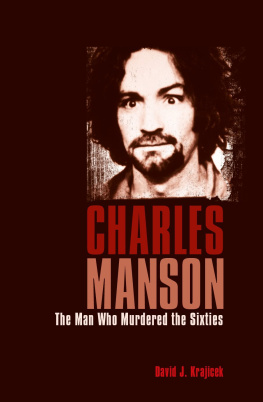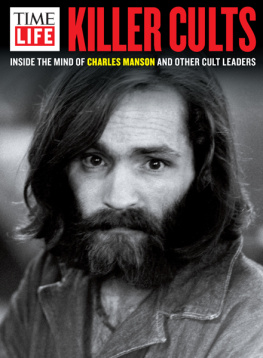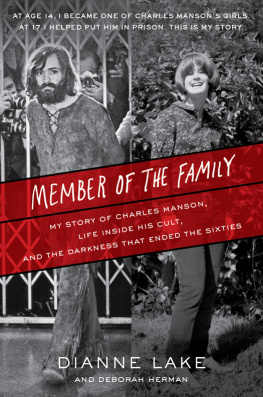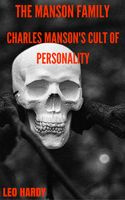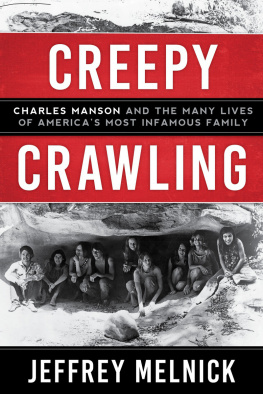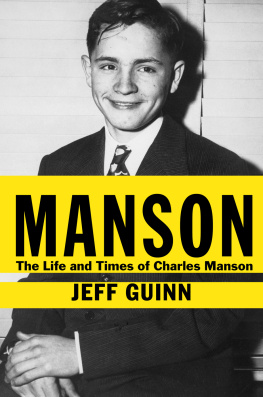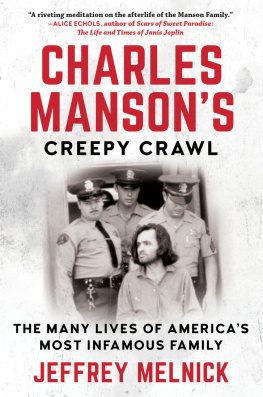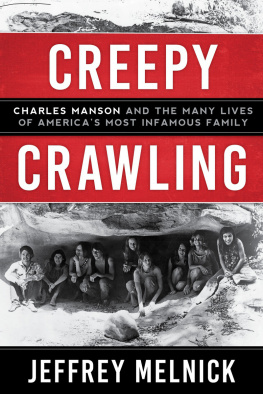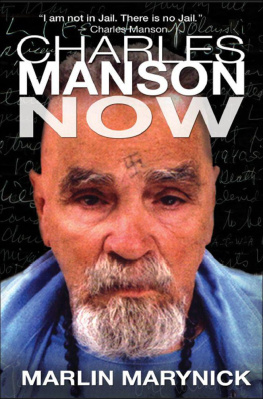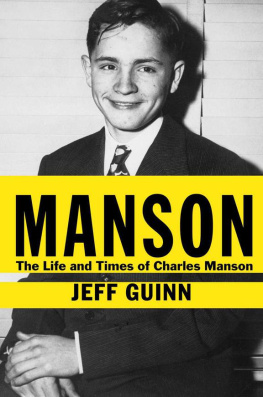David J. Krajicek - Charles Manson : the Man Who Murdered the Sixties
Here you can read online David J. Krajicek - Charles Manson : the Man Who Murdered the Sixties full text of the book (entire story) in english for free. Download pdf and epub, get meaning, cover and reviews about this ebook. year: 2019, genre: Detective and thriller. Description of the work, (preface) as well as reviews are available. Best literature library LitArk.com created for fans of good reading and offers a wide selection of genres:
Romance novel
Science fiction
Adventure
Detective
Science
History
Home and family
Prose
Art
Politics
Computer
Non-fiction
Religion
Business
Children
Humor
Choose a favorite category and find really read worthwhile books. Enjoy immersion in the world of imagination, feel the emotions of the characters or learn something new for yourself, make an fascinating discovery.
- Book:Charles Manson : the Man Who Murdered the Sixties
- Author:
- Genre:
- Year:2019
- Rating:5 / 5
- Favourites:Add to favourites
- Your mark:
- 100
- 1
- 2
- 3
- 4
- 5
Charles Manson : the Man Who Murdered the Sixties: summary, description and annotation
We offer to read an annotation, description, summary or preface (depends on what the author of the book "Charles Manson : the Man Who Murdered the Sixties" wrote himself). If you haven't found the necessary information about the book — write in the comments, we will try to find it.
Charles Manson : the Man Who Murdered the Sixties — read online for free the complete book (whole text) full work
Below is the text of the book, divided by pages. System saving the place of the last page read, allows you to conveniently read the book "Charles Manson : the Man Who Murdered the Sixties" online for free, without having to search again every time where you left off. Put a bookmark, and you can go to the page where you finished reading at any time.
Font size:
Interval:
Bookmark:

On a July day in 1969, a musician named Gary Hinman sat bleeding from a gun clubbing to the head in his bungalow in a Los Angeles canyon. He was chanting the Buddhist daimoku as three home-invader hippie friends were preparing to take his life. Metronomically, Hinman caressed his prayer beads and mouthed the sing-song Lotus Sutra mantra, seeking calm in the midst of overwhelming dread: Namu Myh Renge Ky, Namu Myh Renge Ky, Namu Myh Renge Ky...
Thats good, said Bobby Beausoleil. Keep it up, Gary.
This condescending encouragement came from the 21-year-old leader of a kill team dispatched to Garys home from a commune at an old western movie ranch nearby. Beausoleil and two women, Mary Brunner and Susan Atkins, arrived late on a Friday night, following false rumors that their friend was holding vast sums of money.
They were instructed to offer Hinman two options: turn over the loot or die. Beausoleil phoned the ranch for further orders when Hinman swore that he was broke. Twenty minutes later, two men barged into the house, ironically lifting Hinmans hopes that he might be rescued from the madness. Hardly.
The new arrivals included a tiny man of simian appearance, with sable-colored hair and beard and manic little black eyes. Ominously, he was carrying a sword.
Within minutes of arriving, he slashed a gash into the left side of Hinmans head as the confused victim begged to be told why he was being targeted.
His diminutive assailant then rifled drawers, finding just coins and petty cash, before conferring with Beausoleil and fleeing in Hinmans Fiat station wagon. He was leaving the other three to finish the job.
The slasher was Charles Manson. At age 34, he was a glib jailbird who had emerged from prison three years earlier and stumbled into San Francisco as American ingnues in peasant dressesrunaways, hitchhikers, and lost souls trying to find themselveswere streaming into town for the Summer of Love. His timing was impeccable. The patchouli-scented sexual revolution created a perfect Petri dish for his predation. Using prison-honed talents as a con man and his middling skills as a guitarist and singer-songwriter, Manson soon began building a cult of as many as 35 young hippies, three-quarters of them women.
He would spin campfire lectures for his stoner clan, featuring trite college Psych 101 tutorials about projection and reflection. His enamored followers, none of whom would have been mistaken for an intellectual, mistook his dime-store dogma for deep thinking. He basted their brains in a mix of Jesus Freakiness, Dale Carnegie hucksterisms, Norman Vincent Peales sunny-sided platitudes (You are perfect!), and the buggy self-help triangulations and dynamics of his prison-library Scientology.
They believed he was a mystic. The writer David Dalton, who wrote the first long profile of Manson for Rolling Stone, nailed Manson in eight words: If Christ came back as a con man. Joe Mozingo of the Los Angeles Times drew another vivid analogy: He was a scab mite who bit at the perfect time and place.
Using the playbook of pimps and cult leaders, he isolated troubled young women from their past lives and controlled their bodies and minds. He was the Wizard of Oz for libertines, and he as much as told them so. Susan Atkins, who became one of Mansons most prolific robot killers, said Manson often mocked his own followers blind faith: He said, I have tricked all of you. I have tricked you into doing what I want you to, and I am using you, and you are all aware of that now, and its like Ive got a bunch of slaves around me.

Multiple mugshot of human chameleon Charles Manson during his trial in 1969he kept changing his appearance but the eyes remained the same.
Manson was an enigma on so many levels. His enduring infamy as an object of both fascination and revulsion springs from his ability to mind-control his acolytes. He was imbued with the old-timey gender and racial sensibilities of his Appalachian upbringing. In other words, he was a racist and a sexist. He preached female subservience and racial segregation, and his followers lapped it up amid a flowering civil rights movement and on the cusp of the womens liberation movement. In 1969, the debut of Ms. magazine was just two years distant, and it would be just three years before states began ratifying the Equal Rights Amendment. Yet Mansons women happily subjugated themselves.
Fifty years after Charles Mansons shocking grand entrance as an American true crime icon, this book looks back at how such a murderous mess by a ragtag collection of hippies and hangers-on could have transpired. It delves into the farcical thoughtlessness and naivety of these young men and women who marched along behind their buckskinned faux-Jesus. I let them try to explain themselvessometimes to comic effectin their own words, from transcripts of courtroom or grand jury testimony, recorded interviews with attorneys and the media, and the memoirs and letters many have written.
Leslie Van Houten, who was raised in a churchy family in a middle-class L.A. suburb, was an exemplar of blind faith. At age 19 she stuck a knife into the flesh of another human beingwhich, along with strangulation, is the most tactile and intimate form of murdersimply because Manson told her to do so. She had nothing to gain but little Charlies validation.
Facing her comeuppance months later, Van Houten sat down with a defense attorney named Marvin Part, who tried to tease some sense out of her. Part asked: You said something about thinking Charlie is or was Jesus. Do you still believe that?
Yeah, I still believe he is, Van Houten replied. And, you know, I cant say it in words. Only that hes almost not even human. I mean, you know, hes got his body and all, but hes gentle. I mean hes everything. Hes just everything at once. Its hard, you know, I cant even almost explain him. And its like he has no ego. Do you know what ego is? Its faces that we put on for each other. And he has none of that. Hes just a person. And, well, its so hard to explain why I believe he is, but I know he is.
The attorney asked whether Manson claimed to be Christ.
Van Houten replied: He used to say, I see too much; I see whats happening, and I dont want it; I dont want to be in this position.... Hed say, I know that I died on the cross before.
This seemed reasonable to Van Houten and her doe-eyed cult sister wives.
Manson must have been thinking of Van Houten when he said: You can convince anybody of anything if you just push it at them all of the time. They may not believe it 100 percent, but they will still draw opinions from it, especially if they have no other information to draw their opinions from.
Just 29 months after Manson began assembling these nafs into a communal Familyheartless, bloodthirsty robots... sent out from the fires of hell, as a prosecutor would describe themthey carried out a series of proving-ground murders over four weeks in the summer of 1969 that have endured for half a century in Americas fabled pantheon of crime spectacles. The slayings of pregnant actress Sharon Tate, coffee heiress Abigail Folger, Leno and Rosemary LaBianca, and five others in four separate acts of casual savagery remain today a peerless mashup of celebrity, sex, cult groupthink, and bloodlust.
Font size:
Interval:
Bookmark:
Similar books «Charles Manson : the Man Who Murdered the Sixties»
Look at similar books to Charles Manson : the Man Who Murdered the Sixties. We have selected literature similar in name and meaning in the hope of providing readers with more options to find new, interesting, not yet read works.
Discussion, reviews of the book Charles Manson : the Man Who Murdered the Sixties and just readers' own opinions. Leave your comments, write what you think about the work, its meaning or the main characters. Specify what exactly you liked and what you didn't like, and why you think so.

